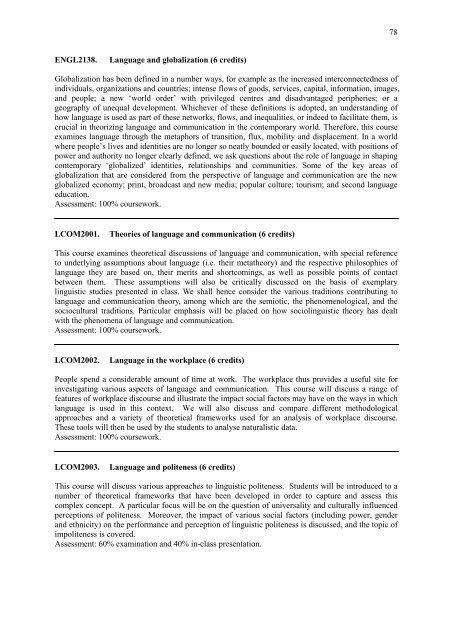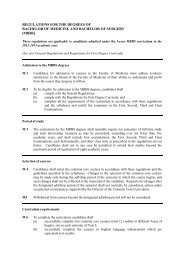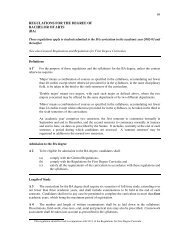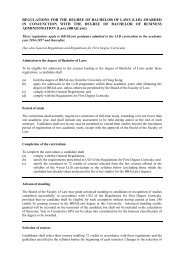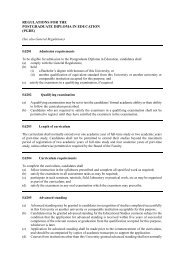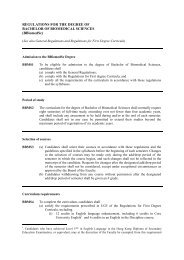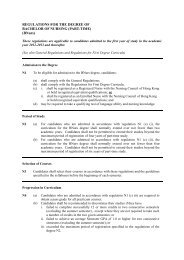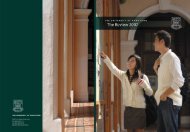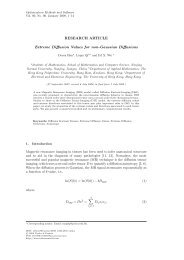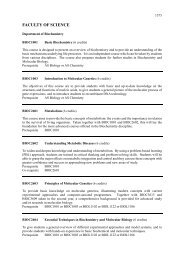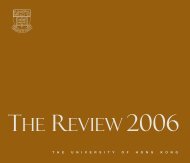(BA) (4-year-programme) - The University of Hong Kong
(BA) (4-year-programme) - The University of Hong Kong
(BA) (4-year-programme) - The University of Hong Kong
You also want an ePaper? Increase the reach of your titles
YUMPU automatically turns print PDFs into web optimized ePapers that Google loves.
78ENGL2138.Language and globalization (6 credits)Globalization has been defined in a number ways, for example as the increased interconnectedness <strong>of</strong>individuals, organizations and countries; intense flows <strong>of</strong> goods, services, capital, information, images,and people; a new ‘world order’ with privileged centres and disadvantaged peripheries; or ageography <strong>of</strong> unequal development. Whichever <strong>of</strong> these definitions is adopted, an understanding <strong>of</strong>how language is used as part <strong>of</strong> these networks, flows, and inequalities, or indeed to facilitate them, iscrucial in theorizing language and communication in the contemporary world. <strong>The</strong>refore, this courseexamines language through the metaphors <strong>of</strong> transition, flux, mobility and displacement. In a worldwhere people’s lives and identities are no longer so neatly bounded or easily located, with positions <strong>of</strong>power and authority no longer clearly defined, we ask questions about the role <strong>of</strong> language in shapingcontemporary ‘globalized’ identities, relationships and communities. Some <strong>of</strong> the key areas <strong>of</strong>globalization that are considered from the perspective <strong>of</strong> language and communication are the newglobalized economy; print, broadcast and new media; popular culture; tourism; and second languageeducation.Assessment: 100% coursework.LCOM2001.<strong>The</strong>ories <strong>of</strong> language and communication (6 credits)This course examines theoretical discussions <strong>of</strong> language and communication, with special referenceto underlying assumptions about language (i.e. their metatheory) and the respective philosophies <strong>of</strong>language they are based on, their merits and shortcomings, as well as possible points <strong>of</strong> contactbetween them. <strong>The</strong>se assumptions will also be critically discussed on the basis <strong>of</strong> exemplarylinguistic studies presented in class. We shall hence consider the various traditions contributing tolanguage and communication theory, among which are the semiotic, the phenomenological, and thesociocultural traditions. Particular emphasis will be placed on how sociolinguistic theory has dealtwith the phenomena <strong>of</strong> language and communication.Assessment: 100% coursework.LCOM2002.Language in the workplace (6 credits)People spend a considerable amount <strong>of</strong> time at work. <strong>The</strong> workplace thus provides a useful site forinvestigating various aspects <strong>of</strong> language and communication. This course will discuss a range <strong>of</strong>features <strong>of</strong> workplace discourse and illustrate the impact social factors may have on the ways in whichlanguage is used in this context. We will also discuss and compare different methodologicalapproaches and a variety <strong>of</strong> theoretical frameworks used for an analysis <strong>of</strong> workplace discourse.<strong>The</strong>se tools will then be used by the students to analyse naturalistic data.Assessment: 100% coursework.LCOM2003.Language and politeness (6 credits)This course will discuss various approaches to linguistic politeness. Students will be introduced to anumber <strong>of</strong> theoretical frameworks that have been developed in order to capture and assess thiscomplex concept. A particular focus will be on the question <strong>of</strong> universality and culturally influencedperceptions <strong>of</strong> politeness. Moreover, the impact <strong>of</strong> various social factors (including power, genderand ethnicity) on the performance and perception <strong>of</strong> linguistic politeness is discussed, and the topic <strong>of</strong>impoliteness is covered.Assessment: 60% examination and 40% in-class presentation.


